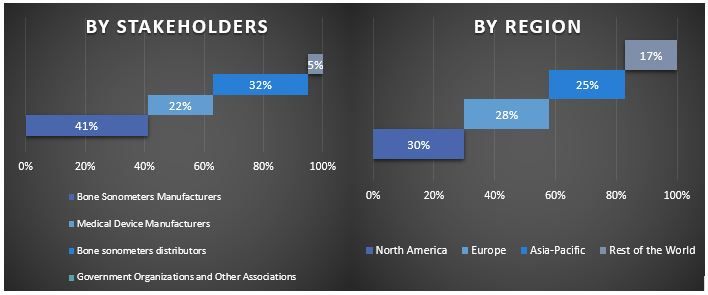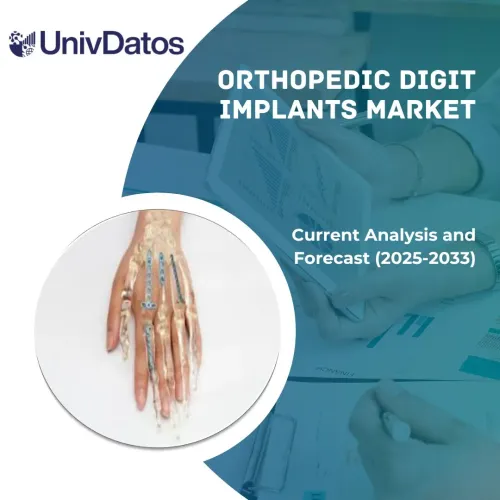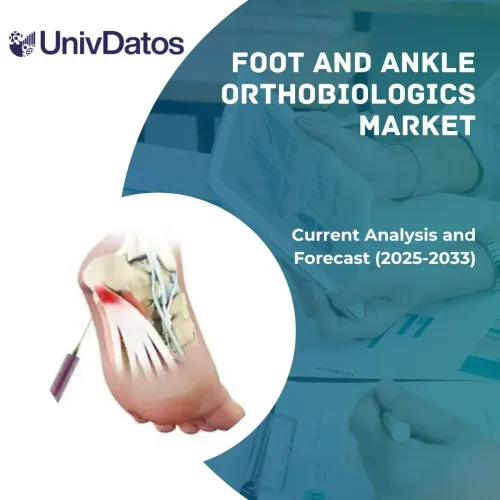- Home
- About Us
- Industry
- Services
- Reading
- Contact Us
Bone Sonometers Market: Current Analysis and Forecast (2024-2032)
Emphasis on Design (Portable Bone Sonometer and Stationary Bone Sonometer), Application (Osteoporosis Screening, Fracture Risk Assessment, Monitoring Bone Health and Others), End-user (Hospitals, Ambulatory Surgical Centers, Clinics and Others); and Region/Country
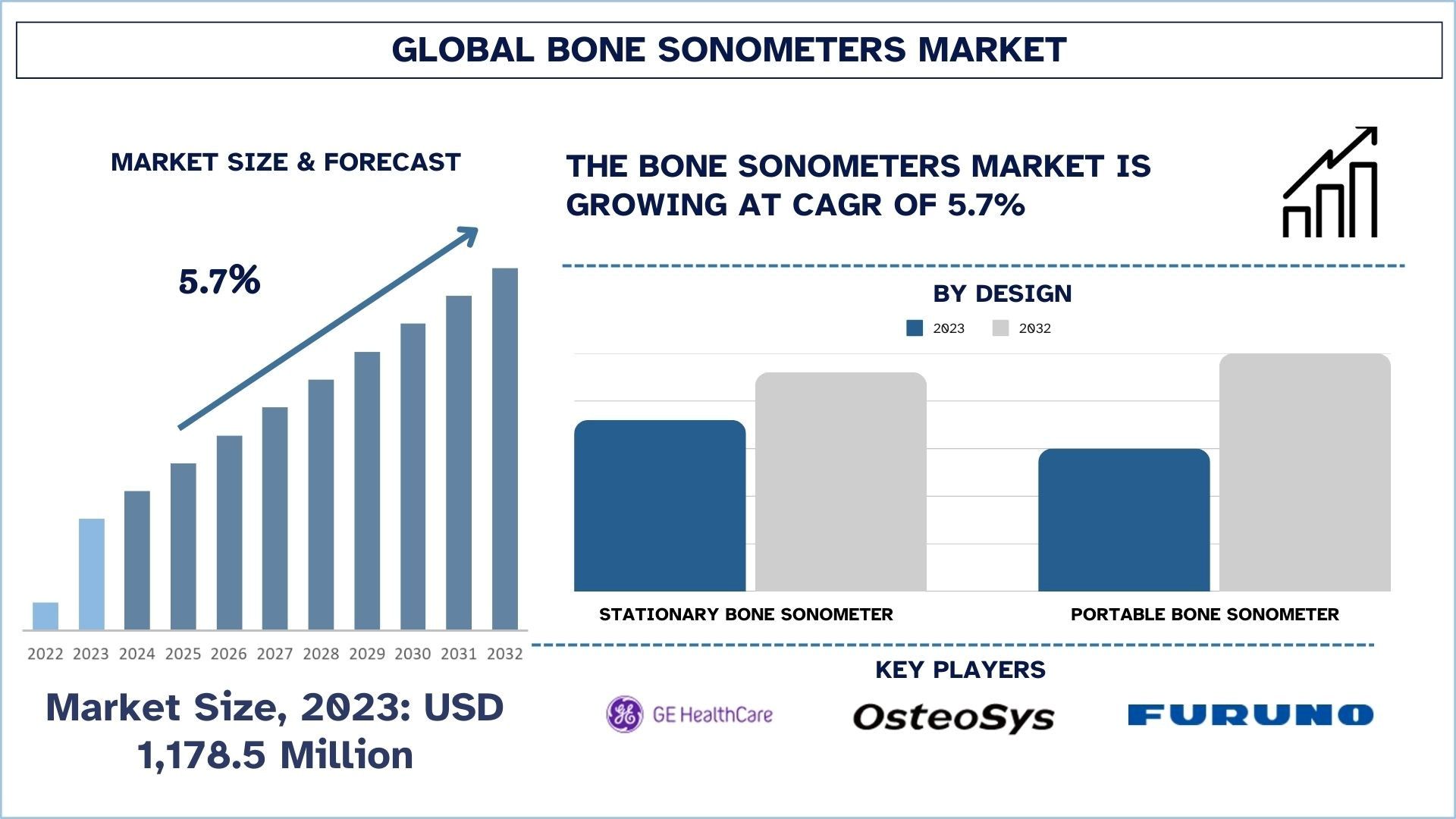
Bone Sonometers Market Size & Forecast
The Bone Sonometers Market was valued at approximately USD 1,178.5 million in 2023 and is expected to grow at a substantial CAGR of around 5.7% during the forecast period (2024-2032) owing to the rise in the prevalence of osteoporosis, advancements in medical devices, and expansion of the preventive healthcare sector.
Bone Sonometers Market Analysis
A bone sonometer is an instrument that diagnoses or supervises bone density and bone quality. It is generally applied for diagnosing illnesses such as osteoporosis. They work on the basis of ultrasonic waves, which determine how these waves propagate through bones. This examination makes use of two characteristic indices, namely the Speed of Sound (SOS) and Broadband Ultrasound Attenuation (BUA) in an effort to assess bone status. It is measured against some normative values based on the age and sex of the patient; denser and healthier bones are better transmitters of sound waves. Bone sonometers are typically applied to peripheral areas of the body, for example, on the heel (calcaneum), fingers, or forearm. As compared to methods like DEXA bone density measurement, bone sonometers are portable, non-ionizing, less expensive, and therefore suitable as a first-line assessment and in clinical areas where DEXA is inaccessible. Although less accurate than the DEXA scans, they enable easy determination of subjects at risk of fractures or assessment of changes in bone density over time.
The bone sonometers market has been propelled by the growing prevalence and incidences of bone-related complications such as osteoporosis and fractures. With the increase in the elderly population and their need for cost-effective and potential methods of bone density assessment, the market is expected to grow significantly. Advancements in preventive care with regard to bone-related diseases are putting pressure on various care providers to embrace non-invasive, portable, and radiation-free equipment such as the bone sonometer. New technologies in ultrasonic diagnostic technology for imaging and the shift from centralized laboratory testing to near-patient testing are also propelling the market’s growth.
Bone Sonometers Market Trends
This section discusses the key market trends influencing the various segments of the bone sonometers market as identified by our research experts.
Increase in Home-Based Screening
The use of bone sonometers is expected to be on the rise due to the increasing popularity of home-based healthcare solutions. As more people embrace preventive measures and prefer patient-friendly care, more people are now using portable diagnostic devices that can be used at home. Self-testing solutions for patients help people screen their status of bones and joints frequently, without revisiting the hospitals which is quite convenient for elderly people and those with mobility impairments. The continuously improved design, size, and simplicity of bone sonometer means that home screening is within the realm of possibility for the majority of patients. Increasing the adoption of diagnosis at home promotes self-management of their bone conditions. Also, with healthcare costs on the rise across the world, home-based screening is cost-efficient and helps ease the early detection of diseases such as osteoporosis. This trend will further grow as the manufacturers continuously come up with new patient-friendly portable bone sonometers.
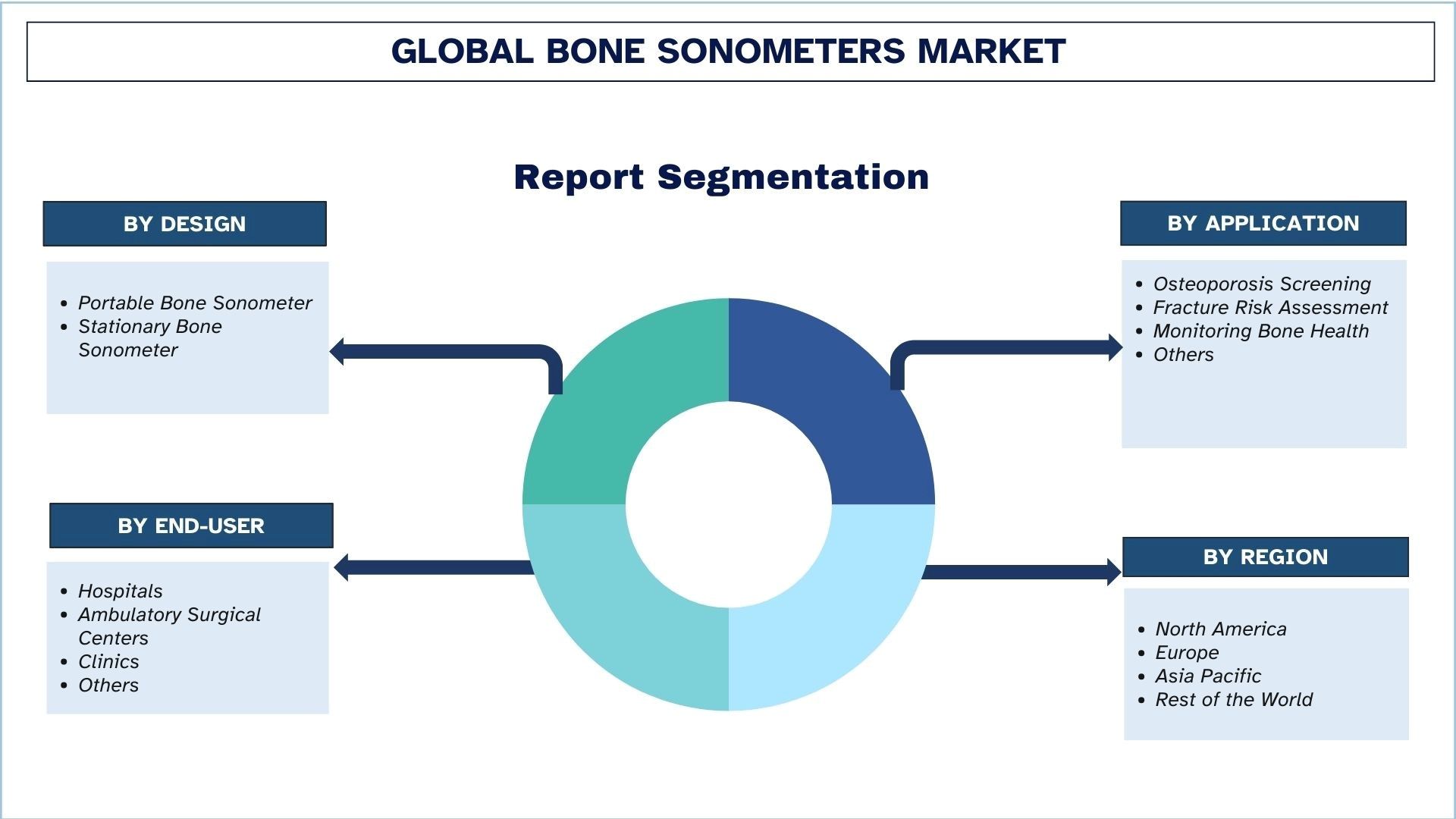
North America has a significant share of the market in 2023.
The North American bone sonometers market is in a growing phase and holds the largest market share for bone sonometers across the world due to the rising incidences of osteoporosis and other bone-related disorders due to the increase in geriatric population and sedentary lifestyle. An increase in patients’ knowledge about the early detection and treatment of bone health disorders has been attributed to the increased use of bone sonometers, which are non-invasive, portable, and effective. The region also has strong healthcare facilities, high average healthcare-related expenditure, and a perfect reimbursement situation which makes diagnostic technologies affordable. Further, the progressively evolving implementation of AI and digital imaging in bone sonometers increases accuracy and ease, creating higher demand. There is growing attention to more prophylactic medical checkups, and an increased trend towards bone density check-ups among high-risk groups including post-menopausal, women is another reason. With the major market participants and highly developed R&D activities, North America continues to advance as a market leader in this sector due to the accelerated rates of innovation and product availability.
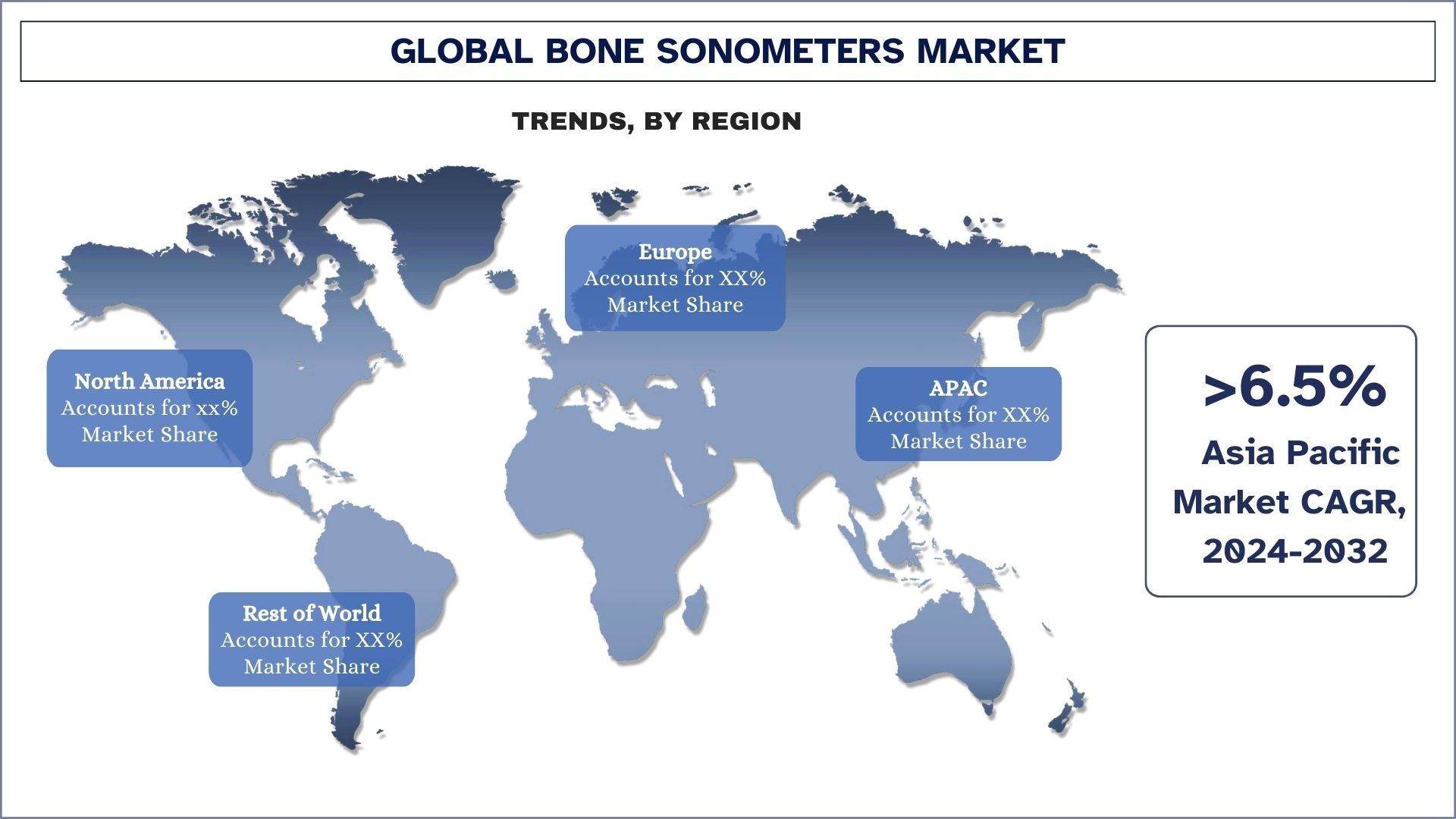
Bone Sonometers Industry Overview
The Bone Sonometers market is competitive, with several global and international players. The key players are adopting different growth strategies to enhance their market presence, such as partnerships, agreements, collaborations, new product launches, geographical expansions, and mergers and acquisitions. Some of the major players operating in the market are GE HealthCare Technologies Inc., CyberLogic, inc., Xuzhou Pinyuan Electronic Technology Co., Ltd., Echolight S.p.a, Furuno Electric, Osteosys, BeamMed Ltd., SonicBone, BMTech Co., Ltd., Life Medical Equipment Co., Ltd.
Bone Sonometers Market News
- In November 2024 - Echolight, a global innovator in bone densitometry, announced that it has signed an agreement enabling Siemens Healthineers to be a reseller of Echolight bone densitometers in support of their Women's Health solutions.
- In November 2022 - Medimaps Group, a Swiss/Global med-tech company specializing in image processing software for assessing bone health, announced that its novel method for enhancing osteoporotic fracture risk assessment, Trabecular Bone Score (TBS iNsight™), a surrogate of bone microarchitecture boosted by AI, is now available on diagnostic platforms from OsteoSys Co., Ltd. OsteoSys is the leading Bone Mineral Densitometer brand in Korea and the third largest supplier of DXA scanning equipment worldwide.
Bone Sonometers Market Report Coverage
Report Attribute | Details |
Base year | 2023 |
Forecast period | 2024-2032 |
Growth momentum | Accelerate at a CAGR of 5.7% |
Market size 2023 | USD 1,178.5 Million |
Regional analysis | North America, Europe, Asia-Pacific, Rest of the World |
Major contributing region | Asia-Pacific is expected to grow at the highest CAGR during the forecasted period. |
Key countries covered | U.S., Canada, Germany, France, UK, Spain, Italy, China, Japan, and India |
Companies profiled | GE HealthCare Technologies Inc., CyberLogic, inc., Xuzhou Pinyuan Electronic Technology Co., Ltd., Echolight S.p.a, Furuno Electric, Osteosys, BeamMed Ltd., SonicBone, BMTech Co., Ltd., Life Medical Equipment Co., Ltd. |
Report Scope | Market Trends, Drivers, and Restraints; Revenue Estimation and Forecast; Segmentation Analysis; Demand and Supply Side Analysis; Competitive Landscape; Company Profiling |
Segments Covered | By Design, By Application, By End-user, By Region/Country |
Reasons to buy this report:
- The study includes market sizing and forecasting analysis validated by authenticated key industry experts.
- The report presents a quick review of overall industry performance at one glance.
- The report covers an in-depth analysis of prominent industry peers with a primary focus on key business financials, product portfolios, expansion strategies, and recent developments.
- Detailed examination of drivers, restraints, key trends, and opportunities prevailing in the industry.
- The study comprehensively covers the market across different segments.
- Deep dive regional level analysis of the industry.
Customization Options:
The global bone sonometers market can be customized further as per the requirement or any other market segment. Besides this, UMI understands that you may have your own business needs, hence feel free to connect with us to get a report that completely suits your requirements.
Table of Content
Research Methodology for the Bone Sonometers Market Analysis (2022-2032)
Analyzing the historical market, estimating the current market, and forecasting the future market of the global bone sonometers market were the three major steps undertaken to create and analyze the adoption of bone sonometers in major regions globally. Exhaustive secondary research was conducted to collect the historical market figures and estimate the current market size. Secondly, to validate these insights, numerous findings and assumptions were taken into consideration. Moreover, exhaustive primary interviews were also conducted with industry experts across the value chain of the global bone sonometers market. Post assumption and validation of market numbers through primary interviews, we employed a top-down/bottom-up approach to forecasting the complete market size. Thereafter, market breakdown and data triangulation methods were adopted to estimate and analyze the market size of segments and sub-segments of the industry. Detailed methodology is explained below:
Analysis of Historical Market Size
Step 1: In-Depth Study of Secondary Sources:
A detailed secondary study was conducted to obtain the historical market size of the bone sonometers market through company internal sources such as annual reports & financial statements, performance presentations, press releases, etc., and external sources including journals, news & articles, government publications, competitor publications, sector reports, third-party database, and other credible publications.
Step 2: Market Segmentation:
After obtaining the historical market size of the bone sonometers market, we conducted a detailed secondary analysis to gather historical market insights and share for different segments & sub-segments for major regions. Major segments are included in the report such as design, application, end-user, and regions. Further country-level analyses were conducted to evaluate the overall adoption of bone sonometers in that region.
Step 3: Factor Analysis:
After acquiring the historical market size of different segments and sub-segments, we conducted a detailed factor analysis to estimate the current market size of the bone sonometers market. Further, we conducted factor analysis using dependent and independent variables such as design, application, end-user, and regions of the bone sonometers market. A thorough analysis was conducted for demand and supply-side scenarios considering top partnerships, mergers and acquisitions, business expansion, and product launches in the bone sonometers market across the globe.
Current Market Size Estimate & Forecast
Current Market Sizing: Based on actionable insights from the above 3 steps, we arrived at the current market size, key players in the global bone sonometers market, and market shares of the segments. All the required percentage shares split, and market breakdowns were determined using the above-mentioned secondary approach and were verified through primary interviews.
Estimation & Forecasting: For market estimation and forecast, weights were assigned to different factors including drivers & trends, restraints, and opportunities available for the stakeholders. After analyzing these factors, relevant forecasting techniques i.e., the top-down/bottom-up approach were applied to arrive at the market forecast for 2032 for different segments and sub-segments across the major markets globally. The research methodology adopted to estimate the market size encompasses:
- The industry’s market size, in terms of revenue (USD) and the adoption rate of the bone sonometers market across the major markets domestically.
- All percentage shares, splits, and breakdowns of market segments and sub-segments.
- Key players in the global bone sonometers market in terms of products offered. Also, the growth strategies adopted by these players to compete in the fast-growing market.
Market Size and Share Validation
Primary Research: In-depth interviews were conducted with the Key Opinion Leaders (KOLs) including Top Level Executives (CXO/VPs, Sales Head, Marketing Head, Operational Head, Regional Head, Country Head, etc.) across major regions. Primary research findings were then summarized, and statistical analysis was performed to prove the stated hypothesis. Inputs from primary research were consolidated with secondary findings, hence turning information into actionable insights.
Split of Primary Participants in Different Regions
Market Engineering
The data triangulation technique was employed to complete the overall market estimation and to arrive at precise statistical numbers for each segment and sub-segment of the global bone sonometers market. Data was split into several segments and sub-segments after studying various parameters and trends in the design, application, end-user, and regions of the global bone sonometers market.
The main objective of the Global Bone Sonometers Market Study
The current & future market trends of the global bone sonometers market were pinpointed in the study. Investors can gain strategic insights to base their discretion for investments on the qualitative and quantitative analysis performed in the study. Current and future market trends determined the overall attractiveness of the market at a regional level, providing a platform for the industrial participant to exploit the untapped market to benefit from a first-mover advantage. Other quantitative goals of the studies include:
- Analyze the current and forecast market size of the bone sonometers market in terms of value (USD). Also, analyze the current and forecast market size of different segments and sub-segments.
- Segments in the study include areas of design, application, end-user, and regions.
- Define and analyze the regulatory framework for the bone sonometers
- Analyze the value chain involved with the presence of various intermediaries, along with analyzing customer and competitor behaviors of the industry.
- Analyze the current and forecast market size of the bone sonometers market for the major region.
- Major countries of regions studied in the report include Asia Pacific, Europe, North America, and the Rest of the World
- Company profiles of the bone sonometers market and the growth strategies adopted by the market players to sustain the fast-growing market.
- Deep dive regional level analysis of the industry.
Frequently Asked Questions FAQs
Q1: What is the bone sonometers market's current size and growth potential?
The bone sonometers market was valued at USD 1,178.5 million in 2023 and is expected to grow at a CAGR of 5.7% during the forecast period (2024-2032).
Q2: What are the driving factors for the growth of the bone sonometers market?
The bone sonometers market is driven by rising osteoporosis prevalence, increasing geriatric population, advancements in diagnostic technologies, and growing awareness of early bone health assessment.
Q3: Which segment has the largest share of the bone sonometers market by design?
The stationary bone sonometers segment has the largest share of the bone sonometers market by design.
Q4: What are the major trends in the bone sonometers market?
Increase in home-based screening and mobile and wireless bone health solutions are the major trends in the bone sonometers market.
Q5: Which region will dominate the bone sonometer market?
North America dominated the market in 2023.
Related Reports
Customers who bought this item also bought

